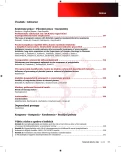Malignant tumours in adult patients after successful treatment of acute myeloid leukemia: long-term experience at the Department of Hemato-Oncology in Olomouc
Authors:
T. Szotkowski 1; Z. Šustková 2; J. Vrbková 3; J. Hubáček 1; L. Raida 1; P. Rohoň 1; A. Kuba 1; R. Szotkowská 1; Z. Pikalová 1; K. Sičová 1; M. Jarošová 1; E. Faber 1; T. Papajík 1; K. Indrák 1
Authors‘ workplace:
Hemato-onkologická klinika, Lékařská fakulta Univerzity Palackého Olomouc
1; Interní hematologická a onkologická klinika, Fakultní nemocnice Brno-Bohunice
2; Ústav molekulární a translační medicíny, Lékařská fakulta Univerzity Palackého Olomouc
3
Published in:
Transfuze Hematol. dnes,19, 2013, No. 4, p. 210-214.
Category:
Comprehensive Reports, Original Papers, Case Reports
Overview
Introduction.
Current curative treatment of acute myeloid leukemia is based on intensive chemotherapy and hematopoietic stem cell transplantation with a significant risk of severe adverse effects, including leukemogenic and cancerogenic ones.
Objectives.
The study is aimed at assessing of incidence and types of malignant tumours in successfully treated acute myeloid leukemia patients.
Methods.
A retrospective analysis consists of 256 patients diagnosed with acute myeloid leukemia at the Department of Hemato-Oncology in Olomouc in 1996-2008 who were treated with intensive chemotherapy and achieved complete remission of the disease.
Results.
Second malignancy occurred in 11 individuals (4.3%) after successful treatment of acute myeloid leukemia. Observed age-standardized incidence of these tumours, 8.29/1,000 person-years, 95% CI = (2.99; 13.58), was not significantly different from the incidence in population. Five patients died of the second malignancy.
Key words:
acute myeloid leukemia, curative treatment, second malignancy
Sources
1. Döhner H, Estey EH, Amadori S, et al. Diagnosis and management of acute myeloid leukemia in adults: recommendations from an international expert panel, on behalf of the European LeukemiaNet. Blood 2010; 115(3): 453-474.
2. Abdallah A, Weber-Nordt RM, Körbling M, Haas R, Ho AD. Long-term outcome in acute myelogenous leukemia autografted with mafosfamide-purged marrow in a single institution: adverse events and incidence of secondary myelodysplasia. Bone Marrow Transplantation 2002; 30: 15-22.
3. Bennett JM, Young ML, Andersen JW, Cassileth PA, Tallman MS, Paietta E, Wiernik PH, Rowe JM. Long-Term Survival in Acute Myeloid Leukemia. Cancer Supplement 1997; 80(11): 2205-2209.
4. Scott Baker K, Ness KK, Weisdorf D, Francisco L, Sun C-L, Forman S, Bhatia S. Late Effects in Survivors of Acute Leukemia Treated with Hematopoietic Cell Transplantation: a Report from the Bone Marrow Transplant Survivor Study Leukemia 2010; 24(12): 2039-2047.
5. Lobe I, Rigal-Huguet F, Vekhoff A, et al. Myelodysplastic syndrome after acute promyelocytic leukemia: the European APL group experience. Leukemia 2003; 17(8): 1600-1604.
6. Esteve J, Benhamou E, Raymond L. Statistical methods in cancer research. Volume IV. Descriptive epidemiology. IARC Sci Publ. 1994; (128): 1-302.
7. Thomas A, Mailankody S, Korde N, Kristinsson SY, Turesson I, Landgren O. Second malignancies after multiple myeloma: from 1960s to 2010s. Blood 2012; 119: 2731-2737.
8. Mauch PM, Kalish LA, Marcus KC, et al. Longterm survival in Hodgkin’s disease relative impact of mortality, second tumors, infection, and cardiovascular disease. Cancer J 1995; 1(1): 33-42.
9. Swerdlow AJ, Barber JA, Hudson GV, et al. Risk of second malignancy after Hodgkin’s disease in a collaborative British cohort: the relation to age at treatment. J Clin Oncol 2000; 18(3): 498-509.
10. Bari A, Marcheselli L, Marcheselli R, Liardo EV, Pozzi S, Ferri P, Sacchi S. Therapy-related myeloid neoplasm in non-hodgkin lymphoma survivors. Mediterr J Hematol Infect Dis 2011; 3(1): e2011065. Epub 2011 Dec 20.
11. Curtis RE, Rowlings PA, Deeg HJ, et al. Solid cancers after bone marrow transplantation. NEJM 1997; 336(13): 897-904.
12. Leung W, Ribeiro RC, Hudson M, et al. Second malignancy after treatment of childhood acute myeloid leukemia. Leukemia 2001; 15(1): 41-45.
13. de Nully Brown P, Hoffmann T, Hansen OP, et al. Long-term survival and development of secondary malignancies in patients with acute myeloid leukemia treated with aclarubicin or daunorubicin plus cytosine arabinoside followed by intensive consolidation chemotherapy in a Danish national phase III trial. Danish Society of Haematology Study Group on AML. Leukemia 1997; 11(1): 37-41.
14. Voglova J, Muzik J, Faber E, et al. Incidence of second malignancies during treatment of chronic myeloid leukemia with tyrosine kinase inhibitors in the Czech Republic and Slovakia. Neoplasma 2011; 58(3): 256-262.
15. Zeiser R, Schnitzler M, Andrlova H, Hellige T, Meiss F. Immunotherapy for malignant melanoma. Curr Stem Cell Res Ther 2012; 7(3): 217-228.
16. Kurokawa T, Fischer K, Bertz H, Hoegerle S, Finke J, Mackensen A. In vitro and in vivo characterization of graft-versus-tumor responses in melanoma patients after allogeneic peripheral blood stem cell transplantation. Int J Cancer 2002; 101(1): 52–60.
17. Szotkowski T, Jarosova M, Faber E, et al. Precursor T-lymphoblastic lymphoma as a secondary malignancy in a young patient after successful treatment of acute promyelocytic leukemia. Onkologie 2009; 32: 513–515.
Labels
Haematology Internal medicine Clinical oncologyArticle was published in
Transfusion and Haematology Today

2013 Issue 4
Most read in this issue
- Phlebotomy and therapeutic apheresis in the treatment of polyglobulia
- Antithrombin
- Stability of coagulation factors in thawed plasma
- Blood cell storage lesion
